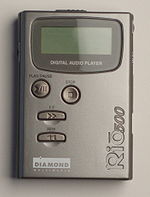
Rio 500
Encyclopedia

MP3
MPEG-1 or MPEG-2 Audio Layer III, more commonly referred to as MP3, is a patented digital audio encoding format using a form of lossy data compression...
digital audio player (portable digital audio player), and was produced by Diamond Multimedia
Diamond Multimedia
Diamond Multimedia is a company that specializes in many forms of multimedia technology. They have produced graphics cards, motherboards, modems, sound cards and MP3 players, however the company began with the production of the TrackStar, a PC add-on card which emulated Apple II computers...
. It shipped September 22, 1999. The Rio 500 was the successor of the Rio PMP300
Rio PMP300
The Rio PMP300 was a portable consumer MP3 digital audio player , and was produced by Diamond Multimedia. It was introduced September 15, 1998, and it shipped later that year.-Features:...
, and provided a number of user requested features (including USB and higher audio quality).
Features
The Rio 500 was the first MP3 player to allow file transfer via USB cable, and PCPersonal computer
A personal computer is any general-purpose computer whose size, capabilities, and original sales price make it useful for individuals, and which is intended to be operated directly by an end-user with no intervening computer operator...
& Mac
Macintosh
The Macintosh , or Mac, is a series of several lines of personal computers designed, developed, and marketed by Apple Inc. The first Macintosh was introduced by Apple's then-chairman Steve Jobs on January 24, 1984; it was the first commercially successful personal computer to feature a mouse and a...
support. It features 64 MB of flash memory available for music, has a backlight, ability to set bookmarks, has an expansion card slot (Smart Media card) and is powered by one AA battery. It is roughly the size of a standard pack of playing cards.

